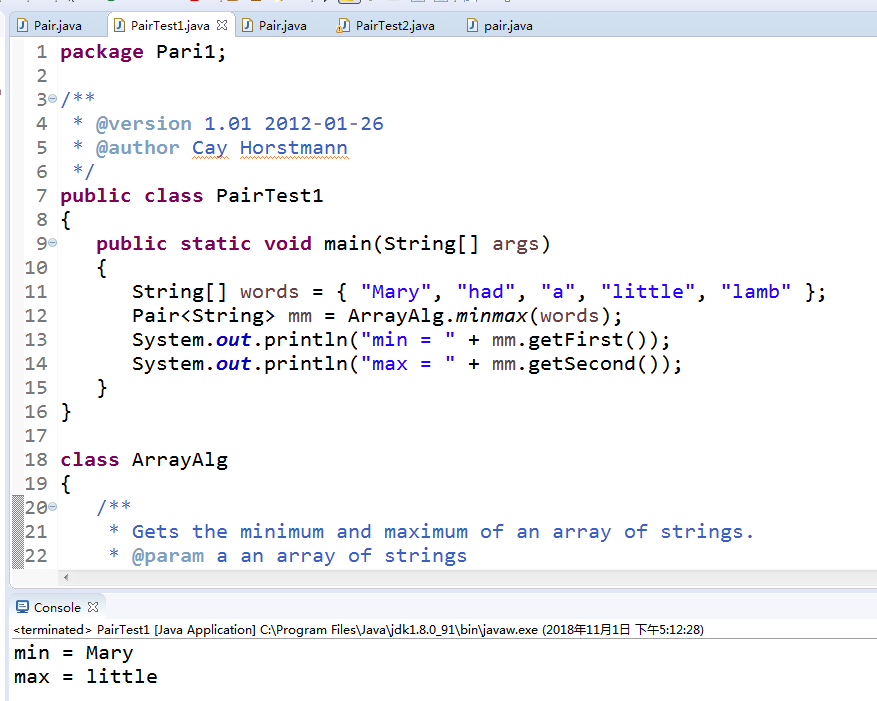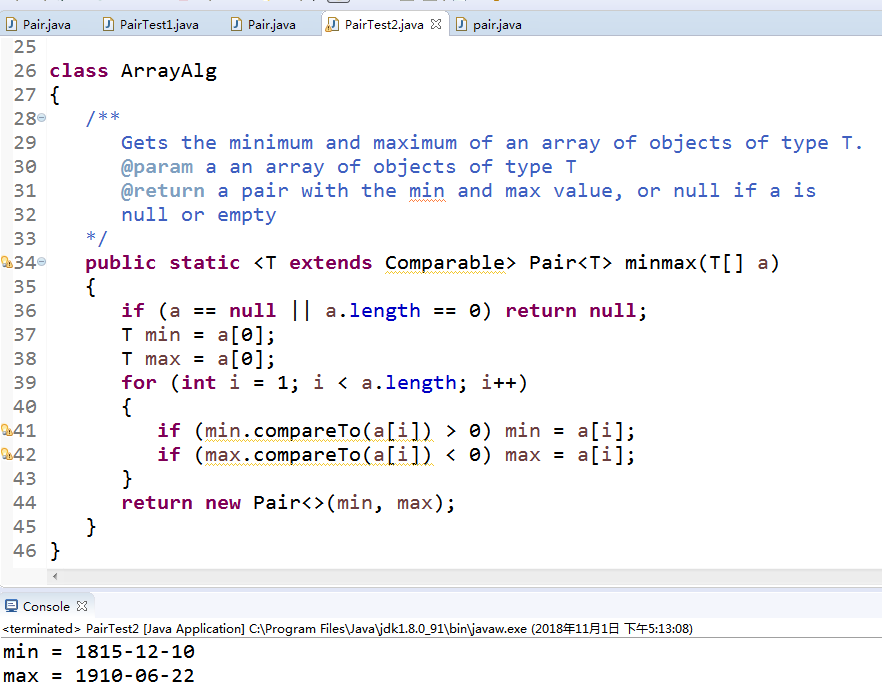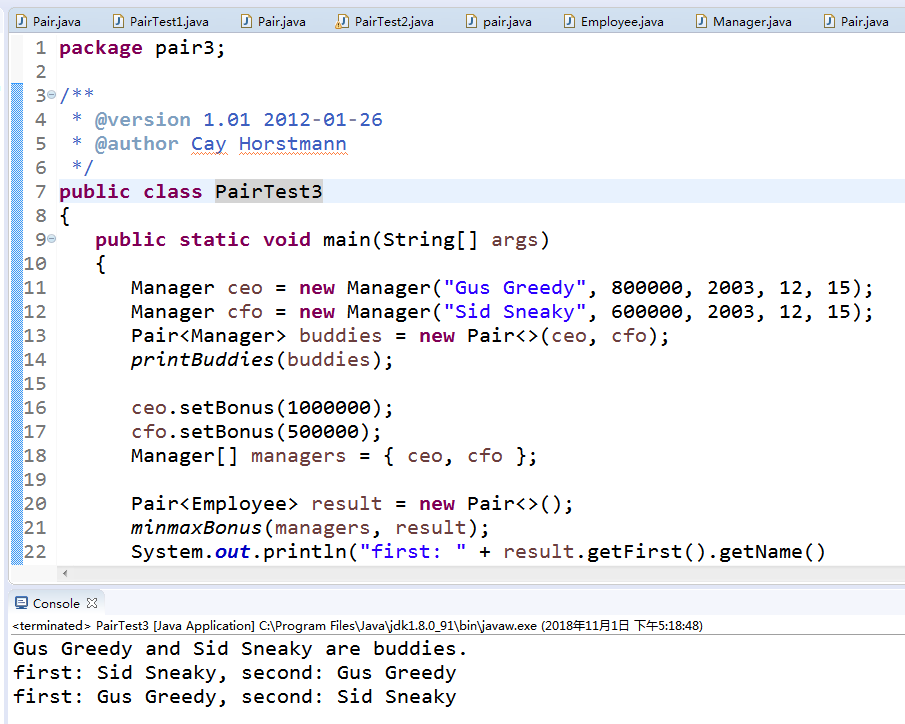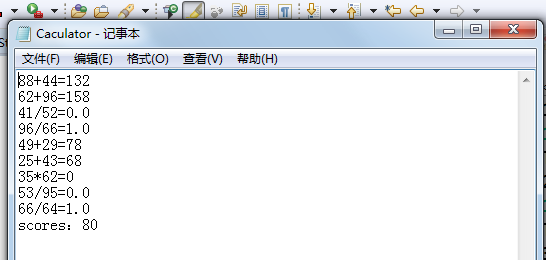201771010126 王燕《面向对象程序设计(Java)》第十周学习总结
实验十 泛型程序设计技术
实验时间 2018-11-1
1、实验目的与要求
(1) 理解泛型概念;
泛型:也称参数化类型(parameterized type),就是在定义类、接口和方法时,通过类型参数指示将要处理的对象类型。(如ArrayList类). 泛型程序设计(Generic programming):编写代码可以被很多不同类型的对象所重用。
(2) 掌握泛型类的定义与使用;
一个泛型类(generic class)就是具有一个或多个类型变量的类,即创建用类型作为参数的类。如一个泛型类定义格式如下:
class Generics<K,V>其中的K和V是类中的可变类型参数。
(3) 掌握泛型方法的声明与使用;
泛型方法
– 除了泛型类外,还可以只单独定义一个方法作
为泛型方法,用于指定方法参数或者返回值为
泛型类型,留待方法调用时确定。
– 泛型方法可以声明在泛型类中,也可以声明在
普通类中。
(4) 掌握泛型接口的定义与实现;
定义:
public interface IPool <T>
{
T get();
int add(T t);
}
实现:
public class GenericPool<T> implements IPool<T>
{
…
}
>
}
public class GenericPool implements IPool<Account>
{
…
}
(5)了解泛型程序设计,理解其用途。
泛型程序设计小结
. 定义一个泛型类时,在“<>”内定义形式类型参数,例如:“class TestGeneric<K, V>”,其中“K” , “V”不代表值,而是表示类型。. 实例化泛型对象的时候,一定要在类名后面指定类型参数的值(类型),一共要有两次书写。例如:
TestGeneric<String, String> t
=new TestGeneric<String, String>();
. 泛型中<T extends Object>, extends并不代表继承,它是类型范围限制。
. 泛型类不是协变的。
2、实验内容和步骤
实验1: 导入第8章示例程序,测试程序并进行代码注释。
测试程序1:
l 编辑、调试、运行教材311、312页 代码,结合程序运行结果理解程序;
l 在泛型类定义及使用代码处添加注释;
l 掌握泛型类的定义及使用。
public class pair<T>//T是类型变量或参数化变量
{
private T first;
private T second;
public pair()
{
first = null; second = null;
}
public pair(T first, T second)
{
this.first = first;
this.second = second;
}
public T getFirst()
{
return first;
}
public T getSecond()
{
return second;
}
public void setFirst(T newValue)
{
first = newValue;
}
public void setSecond(T newValue)
{
second = newValue;
}
}
package Pari1; /**
* @version 1.00 2004-05-10
* @author Cay Horstmann
*/
public class Pair<T>
{
private T first;
private T second; public Pair() { first = null; second = null; }
public Pair(T first, T second) { this.first = first; this.second = second; } public T getFirst() { return first; }
public T getSecond() { return second; } public void setFirst(T newValue) { first = newValue; }
public void setSecond(T newValue) { second = newValue; }
}
package Pari1; /**
* @version 1.01 2012-01-26
* @author Cay Horstmann
*/
public class PairTest1
{
public static void main(String[] args)
{
String[] words = { "Mary", "had", "a", "little", "lamb" };
Pair<String> mm = ArrayAlg.minmax(words);
System.out.println("min = " + mm.getFirst());
System.out.println("max = " + mm.getSecond());
}
} class ArrayAlg
{
/**
* Gets the minimum and maximum of an array of strings.
* @param a an array of strings
* @return a pair with the min and max value, or null if a is null or empty
*/
public static Pair<String> minmax(String[] a)
{
if (a == null || a.length == 0) return null;
String min = a[0];
String max = a[0];
for (int i = 1; i < a.length; i++)
{
if (min.compareTo(a[i]) > 0) min = a[i];
if (max.compareTo(a[i]) < 0) max = a[i];
}
return new Pair<>(min, max);
}
}

测试程序2:
l 编辑、调试运行教材315页 PairTest2,结合程序运行结果理解程序;
l 在泛型程序设计代码处添加相关注释;
l 掌握泛型方法、泛型变量限定的定义及用途。
package Pair2; /**
* @version 1.00 2004-05-10
* @author Cay Horstmann
*/
public class Pair<T>
{
private T first;
private T second; public Pair() { first = null; second = null; }
public Pair(T first, T second) { this.first = first; this.second = second; } public T getFirst() { return first; }
public T getSecond() { return second; } public void setFirst(T newValue) { first = newValue; }
public void setSecond(T newValue) { second = newValue; }
}
package Pair2; import java.time.*; /**
* @version 1.02 2015-06-21
* @author Cay Horstmann
*/
public class PairTest2
{
public static void main(String[] args)
{
LocalDate[] birthdays =
{
LocalDate.of(1906, 12, 9), // G. Hopper
LocalDate.of(1815, 12, 10), // A. Lovelace
LocalDate.of(1903, 12, 3), // J. von Neumann
LocalDate.of(1910, 6, 22), // K. Zuse
};
Pair<LocalDate> mm = ArrayAlg.minmax(birthdays);
System.out.println("min = " + mm.getFirst());
System.out.println("max = " + mm.getSecond());
}
} class ArrayAlg
{
/**
Gets the minimum and maximum of an array of objects of type T.
@param a an array of objects of type T
@return a pair with the min and max value, or null if a is
null or empty
*/
public static <T extends Comparable> Pair<T> minmax(T[] a)
{
if (a == null || a.length == 0) return null;
T min = a[0];
T max = a[0];
for (int i = 1; i < a.length; i++)
{
if (min.compareTo(a[i]) > 0) min = a[i];
if (max.compareTo(a[i]) < 0) max = a[i];
}
return new Pair<>(min, max);
}
}

测试程序3:
l 用调试运行教材335页 PairTest3,结合程序运行结果理解程序;
l 了解通配符类型的定义及用途。
package pair3; import java.time.*; public class Employee
{
private String name;
private double salary;
private LocalDate hireDay; public Employee(String name, double salary, int year, int month, int day)
{
this.name = name;
this.salary = salary;
hireDay = LocalDate.of(year, month, day);
} public String getName()
{
return name;
} public double getSalary()
{
return salary;
} public LocalDate getHireDay()
{
return hireDay;
} public void raiseSalary(double byPercent)
{
double raise = salary * byPercent / 100;
salary += raise;
}
}
package pair3; public class Manager extends Employee
{
private double bonus; /**
@param name the employee's name
@param salary the salary
@param year the hire year
@param month the hire month
@param day the hire day
*/
public Manager(String name, double salary, int year, int month, int day)
{
super(name, salary, year, month, day);
bonus = 0;
} public double getSalary()
{
double baseSalary = super.getSalary();
return baseSalary + bonus;
} public void setBonus(double b)
{
bonus = b;
} public double getBonus()
{
return bonus;
}
}
package pair3; /**
* @version 1.00 2004-05-10
* @author Cay Horstmann
*/
public class Pair<T> //T是类型变量或参数化变量
{
private T first;
private T second; public Pair() { first = null; second = null; }
public Pair(T first, T second) { this.first = first; this.second = second; } public T getFirst() { return first; }
public T getSecond() { return second; } public void setFirst(T newValue) { first = newValue; }
public void setSecond(T newValue) { second = newValue; }
}
package pair3; /**
* @version 1.01 2012-01-26
* @author Cay Horstmann
*/
public class PairTest3
{
public static void main(String[] args)
{
Manager ceo = new Manager("Gus Greedy", 800000, 2003, 12, 15);
Manager cfo = new Manager("Sid Sneaky", 600000, 2003, 12, 15);
Pair<Manager> buddies = new Pair<>(ceo, cfo);
printBuddies(buddies); ceo.setBonus(1000000);
cfo.setBonus(500000);
Manager[] managers = { ceo, cfo }; Pair<Employee> result = new Pair<>();
minmaxBonus(managers, result);
System.out.println("first: " + result.getFirst().getName()
+ ", second: " + result.getSecond().getName());
maxminBonus(managers, result);
System.out.println("first: " + result.getFirst().getName()
+ ", second: " + result.getSecond().getName());
} public static void printBuddies(Pair<? extends Employee> p)
{
Employee first = p.getFirst();
Employee second = p.getSecond();
System.out.println(first.getName() + " and " + second.getName() + " are buddies.");
} public static void minmaxBonus(Manager[] a, Pair<? super Manager> result)
{
if (a.length == 0) return;
Manager min = a[0];
Manager max = a[0];
for (int i = 1; i < a.length; i++)
{
if (min.getBonus() > a[i].getBonus()) min = a[i];
if (max.getBonus() < a[i].getBonus()) max = a[i];
}
result.setFirst(min);
result.setSecond(max);
} public static void maxminBonus(Manager[] a, Pair<? super Manager> result)
{
minmaxBonus(a, result);
PairAlg.swapHelper(result); // OK--swapHelper captures wildcard type
}
// Can't write public static <T super manager> ...
} class PairAlg
{
public static boolean hasNulls(Pair<?> p)/*(?)类型变量的通配符,“?”符号表明参数的类型可以是任何一种类
型,它和参数T的含义是有区别的。T表示一种 未知类型,而“?”表示任何一种类型。这种通配符一般有以下三种用法:
– 单独的?,用于表示任何类型。
– ? extends type,表示带有上界。
– ? super type,表示带有下界。*/
{
return p.getFirst() == null || p.getSecond() == null;
} public static void swap(Pair<?> p) { swapHelper(p); } public static <T> void swapHelper(Pair<T> p)
{
T t = p.getFirst();
p.setFirst(p.getSecond());
p.setSecond(t);
}
}

实验2:编程练习:
编程练习1:实验九编程题总结
l 实验九编程练习1总结(从程序总体结构说明、模块说明,目前程序设计存在的困难与问题三个方面阐述)。
import java.io.BufferedReader;
import java.io.File;
import java.io.FileInputStream;
import java.io.FileNotFoundException;
import java.io.IOException;
import java.io.InputStreamReader;
import java.util.ArrayList;
import java.util.Arrays;
import java.util.Collections;
import java.util.Scanner; public class Check{
private static ArrayList<Student> studentlist;
public static void main(String[] args) {
studentlist = new ArrayList<>();
Scanner scanner = new Scanner(System.in);
File file = new File("G:\\JAVA\\实验\\身份证号.txt");//导入文本文件
try {
FileInputStream fis = new FileInputStream(file);
BufferedReader in = new BufferedReader(new InputStreamReader(fis));
String temp = null;
while ((temp = in.readLine()) != null) { Scanner linescanner = new Scanner(temp);//创建输入流,与文本文件中的信息进行匹配 linescanner.useDelimiter(" ");
String name = linescanner.next();
String number = linescanner.next();
String sex = linescanner.next();
String age = linescanner.next();
String province =linescanner.nextLine();
Student student = new Student();
student.setName(name);
student.setnumber(number);
student.setsex(sex);
int a = Integer.parseInt(age);
student.setage(a);
student.setprovince(province);
studentlist.add(student); }
} catch (FileNotFoundException e) {
System.out.println("学生信息文件找不到");
e.printStackTrace();
} catch (IOException e) {
System.out.println("学生信息文件读取错误");
e.printStackTrace();
}
boolean isTrue = true;
while (isTrue) {
System.out.println("选择你的操作,输入正确格式的选项");//控制台输出用户的选择
System.out.println("1.按姓名字典序输出人员信息");
System.out.println("2.输出年龄最大和年龄最小的人");
System.out.println("3.查找老乡");
System.out.println("4.查找年龄相近的人");
System.out.println("5.退出");
String m = scanner.next();
switch (m) {//使用catch语句对用户的选择作不同的操作
case "1":
Collections.sort(studentlist);
System.out.println(studentlist.toString());
break;
case "2":
int max=0,min=100;
int j,k1 = 0,k2=0;
for(int i=1;i<studentlist.size();i++)
{
j=studentlist.get(i).getage();
if(j>max)
{
max=j;
k1=i;
}
if(j<min)
{
min=j;
k2=i;
} }
System.out.println("年龄最大:"+studentlist.get(k1));
System.out.println("年龄最小:"+studentlist.get(k2));
break;
case "3":
System.out.println("输入省份");
String find = scanner.next();
String place=find.substring(0,3);
for (int i = 0; i <studentlist.size(); i++)
{
if(studentlist.get(i).getprovince().substring(1,4).equals(place))
System.out.println("老乡"+studentlist.get(i));
}
break; case "4":
System.out.println("年龄:");
int yourage = scanner.nextInt();
int near=agenear(yourage);
int value=yourage-studentlist.get(near).getage();
System.out.println(""+studentlist.get(near));
break;
case "5":
isTrue = false;
System.out.println("退出程序!");
break;
default:
System.out.println("输入有误"); }
}
}
public static int agenear(int age) {
int j=0,min=53,value=0,k=0;
for (int i = 0; i < studentlist.size(); i++)
{
value=studentlist.get(i).getage()-age;
if(value<0) value=-value;
if (value<min)
{
min=value;
k=i;
}
}
return k;
} }
public class Student implements Comparable<Student> {
private String name;
private String number ;
private String sex ;
private int age;
private String province;
public String getName() {//创建主类所需的变量所使用的一系列方法
return name;
}
public void setName(String name) {
this.name = name;
}
public String getnumber() {
return number;
}
public void setnumber(String number) {
this.number = number;
}
public String getsex() {
return sex ;
}
public void setsex(String sex ) {
this.sex =sex ;
}
public int getage() {
return age;
}
public void setage(int age) {
// int a = Integer.parseInt(age);
this.age= age;
}
public String getprovince() {
return province;
}
public void setprovince(String province) {
this.province=province ;
}
public int compareTo(Student o) {
return this.name.compareTo(o.getName());
}
public String toString() {
return name+"\t"+sex+"\t"+age+"\t"+number+"\t"+province+"\n";
}
}
程序总体结结构:
Check类作为主类
Student类实现Comparable<Student>接口
模块说明:
主类Check类模块说明:1.导入文本文件;2.创建输入流,与文本文件中的信息进行匹配;3.控制台输出用户的选择,并使用catch语句对用户的选择作不同的操作
Student类模块说明:创建主类所需的变量所使用的一系列方法
目前设计程序存在的困难与问题:导入文本文件失败时的处理方式;由于C语言中没有Boolean类型,程序中对Boolean类型在整个程序中的使用不够熟练,常常使用较长的判断语句而忽略了布尔类型的运用
l 实验九编程练习2总结(从程序总体结构说明、模块说明,目前程序设计存在的困难与问题三个方面阐述)。
import java.io.FileNotFoundException;
import java.io.PrintWriter;
import java.util.Scanner;
public class Caculator {
public static void main(String[] args) {
Scanner in = new Scanner(System.in);
Caculator1 computing=new Caculator1();
PrintWriter output = null;
try {
output = new PrintWriter("Caculator.txt");//将程序所出的十道题目以及用户的作答以文本形式保存在Caculator.txt中
} catch (Exception e) {
}
int sum = 0; for (int i = 1; i < 11; i++) {
int a = (int) Math.round(Math.random() * 100);//在0到100以内随机生成两个数作为用算数据
int b = (int) Math.round(Math.random() * 100);//在0到3内随机生成一个数作为运算符号的选择符号
int s = (int) Math.round(Math.random() * 3);
switch(s)//在0到3内随机生成一个数作为运算符号的选择符号进行匹配相应的运算
{
case 1:
System.out.println(i+": "+a+"/"+b+"=");
while(b==0){
b = (int) Math.round(Math.random() * 100);
}
double c = in.nextDouble();
output.println(a+"/"+b+"="+c);
if (c == (double)computing.division(a, b)) {
sum += 10;
System.out.println("T");
}
else {
System.out.println("F");
} break; case 2:
System.out.println(i+": "+a+"*"+b+"=");
int c1 = in.nextInt();
output.println(a+"*"+b+"="+c1);
if (c1 == computing.multiplication(a, b)) {
sum += 10;
System.out.println("T");
}
else {
System.out.println("F");
}
break;
case 3:
System.out.println(i+": "+a+"+"+b+"=");
int c2 = in.nextInt();
output.println(a+"+"+b+"="+c2);
if (c2 == computing.addition(a, b)) {
sum += 10;
System.out.println("T");
}
else {
System.out.println("F");
} break ;
case 4:
System.out.println(i+": "+a+"-"+b+"=");
int c3 = in.nextInt();
output.println(a+"-"+b+"="+c3);
if (c3 == computing.subtraction(a, b)) {
sum += 10;
System.out.println("T");
}
else {
System.out.println("F");
}
break ; } }
System.out.println("scores:"+sum);//每答对一道题相应的得到10分,最后将所有分数进行累加并且答应输出
output.println("scores:"+sum);
output.close(); }
}
class Caculator1
{
private int a;//创建变量,
private int b;
public int addition(int a,int b)//定义四种运算方法
{
return a+b;
}
public int subtraction(int a,int b)
{
if((a-b)<0)
return 0;
else
return a-b;
}
public int multiplication(int a,int b)
{
return a*b;
}
public int division(int a,int b)
{
if(b!=0)
return a/b;
else
return 0;
} }
程序总体结结构:
主类Caculator和Caculator1组成
模块说明:
主类Caculator:1.将程序所出的十道题目以及用户的作答以文本形式保存在Caculator.txt中;2.在0到100以内随机生成两个数作为用算数据,在0到3内随机生成一个数作为运算符号的选择符号;3.使用catch语句对0到3内随机生成一个数作为运算符号的选择符号进行匹配相应的运算;4.每答对一道题相应的得到10分,最后将所有分数进行累加并且答应输出
Caculator1类:创建变量,并且定义四种运算方法
目前设计程序存在的困难与问题:将用户输入以及控制台输入保存为文本形式的操作不熟练,没有很好的掌握;以及用算中一些小学生涉及不到的运算知识,例如相减后结果为负号,以及除法运算后出现小数,甚至无线小数的情况没有做具体的改进方法
编程练习2:采用泛型程序设计技术改进实验九编程练习2,使之可处理实数四则运算,其他要求不变。
import java.io.FileNotFoundException;
import java.io.PrintWriter;
import java.util.Scanner;
public class Caculator {
public static void main(String[] args) {
Scanner in = new Scanner(System.in);
Caculator1 computing=new Caculator1();
PrintWriter output = null;
try {
output = new PrintWriter("Caculator.txt");//将程序所出的十道题目以及用户的作答以文本形式保存在Caculator.txt中
} catch (Exception e) {
}
int sum = 0; for (int i = 1; i < 11; i++) {
int a = (int) Math.round(Math.random() * 100);//在0到100以内随机生成两个数作为用算数据
int b = (int) Math.round(Math.random() * 100);//在0到3内随机生成一个数作为运算符号的选择符号
int s = (int) Math.round(Math.random() * 3);
switch(s)//在0到3内随机生成一个数作为运算符号的选择符号进行匹配相应的运算
{
case 1:
System.out.println(i+": "+a+"/"+b+"=");
while(b==0){
b = (int) Math.round(Math.random() * 100);
}
double c = in.nextDouble();
output.println(a+"/"+b+"="+c);
if (c == (double)computing.division(a, b)) {
sum += 10;
System.out.println("T");
}
else {
System.out.println("F");
} break; case 2:
System.out.println(i+": "+a+"*"+b+"=");
int c1 = in.nextInt();
output.println(a+"*"+b+"="+c1);
if (c1 == computing.multiplication(a, b)) {
sum += 10;
System.out.println("T");
}
else {
System.out.println("F");
}
break;
case 3:
System.out.println(i+": "+a+"+"+b+"=");
int c2 = in.nextInt();
output.println(a+"+"+b+"="+c2);
if (c2 == computing.addition(a, b)) {
sum += 10;
System.out.println("T");
}
else {
System.out.println("F");
} break ;
case 4:
System.out.println(i+": "+a+"-"+b+"=");
int c3 = in.nextInt();
output.println(a+"-"+b+"="+c3);
if (c3 == computing.subtraction(a, b)) {
sum += 10;
System.out.println("T");
}
else {
System.out.println("F");
}
break ; } }
System.out.println("scores:"+sum);//每答对一道题相应的得到10分,最后将所有分数进行累加并且答应输出
output.println("scores:"+sum);
output.close(); }
}
class Caculator1
{
private int a;//创建变量,
private int b;
public int addition(int a,int b)//定义四种运算方法
{
return a+b;
}
public int subtraction(int a,int b)
{
if((a-b)<0)
return 0;
else
return a-b;
}
public int multiplication(int a,int b)
{
return a*b;
}
public int division(int a,int b)
{
if(b!=0)
return a/b;
else
return 0;
} }


实验总结:泛型程序主要应用于相似场景下不同的类以及对象,定义泛型类时用尖括号将引入的类型变量括起来跟在类名之后;泛型变量的上界的定义:public class NumberGeneric< T extends Number>:泛型变量的下界的定义:List<? super CashCard> cards = new ArrayList<T>();Java中的数组是协变的,但泛型类型不满足这一原理;“?”符号表明参数的类型可以是任何一种类
型,它和参数T的含义是有区别的。T表示一种
未知类型,而“?”表示任何一种类型。这种
通配符一般有以下三种用法:
– 单独的?,用于表示任何类型。
– ? extends type,表示带有上界。
– ? super type,表示带有下界。
实例化泛型对象的时候,一定要在类名后面指定类
型参数的值(类型),一共要有两次书写。例如:
TestGeneric<String, String> t
=new TestGeneric<String, String>();
泛型中<T extends Object>, extends并不代表继
承,它是类型范围限制。
201771010126 王燕《面向对象程序设计(Java)》第十周学习总结的更多相关文章
- 201771010134杨其菊《面向对象程序设计java》第九周学习总结
第九周学习总结 第一部分:理论知识 异常.断言和调试.日志 1.捕获 ...
- 201871010132-张潇潇《面向对象程序设计(java)》第一周学习总结
面向对象程序设计(Java) 博文正文开头 项目 内容 这个作业属于哪个课程 https://www.cnblogs.com/nwnu-daizh/ 这个作业的要求在哪里 https://www.cn ...
- 扎西平措 201571030332《面向对象程序设计 Java 》第一周学习总结
<面向对象程序设计(java)>第一周学习总结 正文开头: 项目 内容 这个作业属于哪个课程 https://www.cnblogs.com/nwnu-daizh/ 这个作业的要求在哪里 ...
- 201871010124 王生涛《面向对象程序设计JAVA》第一周学习总结
项目 内容 这个作业属于哪个课程 https://www.cnblogs.com/nwnu-daizh/ 这个作业的要求在哪里 https://edu.cnblogs.com/campus/xbsf/ ...
- 201871010115——马北《面向对象程序设计JAVA》第二周学习总结
项目 内容 这个作业属于哪个课程 https://www.cnblogs.com/nwnu-daizh/ 这个作业的要求在哪里 https://www.cnblogs.com/nwnu-daizh/p ...
- 杨其菊201771010134《面向对象程序设计Java》第二周学习总结
第三章 Java基本程序设计结构 第一部分:(理论知识部分) 本章主要学习:基本内容:数据类型:变量:运算符:类型转换,字符串,输入输出,控制流程,大数值以及数组. 1.基本概念: 1)标识符:由字母 ...
- 201777010217-金云馨《面向对象程序设计(Java)》第二周学习总结
项目 内容 这个作业属于哪个课程 https://www.cnblogs.com/nwnu-daizh/ 这个作业的要求在哪里 https://www.cnblogs.com/nwnu-daizh/p ...
- 201871010132——张潇潇《面向对象程序设计JAVA》第二周学习总结
项目 内容 这个作业属于哪个课程 https://www.cnblogs.com/nwnu-daizh/ 这个作业的要求在哪里 https://www.cnblogs.com/nwnu-daizh/p ...
- 201771010123汪慧和《面向对象程序设计Java》第二周学习总结
一.理论知识部分 1.标识符由字母.下划线.美元符号和数字组成, 且第一个符号不能为数字.标识符可用作: 类名.变量名.方法名.数组名.文件名等.第二部分:理论知识学习部分 2.关键字就是Java语言 ...
- 20155303 2016-2017-2 《Java程序设计》第十周学习总结
20155303 2016-2017-2 <Java程序设计>第十周学习总结 目录 学习内容总结 网络编程 数据库 教材学习中的问题和解决过程 代码调试中的问题和解决过程 代码托管 上周考 ...
随机推荐
- app接口中Http请求头示例
POST /v5/simProduct/getProductDetails HTTP/1.1 Accept:image/jsonHost: netroam.mihome.xiaomi.netUser- ...
- OSL
1,SimpleColorShader: shader gamma(color cin = color(,,),output color Cout=color(,,)) { Cout = cin; } ...
- 生产宕机dunp配置
修改线程数 <self-tuning-thread-pool-size-min>100</self-tuning-thread-pool-size-min> <self- ...
- 解决百度上传WebUploader在IE浏览器下点击无反应的问题
原因1:IE浏览器不支持H5方式上传,需要使用flash的方式上传 解决方法:在页面head标签添加<meta http-equiv="X-UA-Compatible" co ...
- java爬虫实现爬取百度风云榜Top10
最近在项目中遇到了java和python爬虫进行程序调用和接口对接的问题, 刚开始也是调试了好久才得出点门道. 而后,自己也发现了爬虫的好玩之处,边想着用java来写个爬虫玩玩,虽说是个不起眼的dem ...
- Python判断输入字符类型
"""从键盘上输入 一个字符,判断其字符类型.""" while True: char = input("请输入需要判断的字符:& ...
- JS中函数常见的表现形式以及立即执行函数
函数常见的几种表现形式: 1.一般形式(函数声明): 会进行函数的预解释,函数会进行声明和定义,在函数体前面或则后面都可以进行调用. 2.函数表达式(匿名函数): 会进行函数的预解析,函数会进行声明但 ...
- 基于.net的分布式系统限流组件(限流算法:令牌算法和漏斗算法)
转载链接:https://www.cnblogs.com/vveiliang/p/9049393.html 1.令牌桶算法 令牌桶算法是比较常见的限流算法之一,大概描述如下: 1).所有的请求在处理之 ...
- 一起学爬虫——如何爬取通过ajax加载数据的网站
目前很多网站都使用ajax技术动态加载数据,和常规的网站不一样,数据时动态加载的,如果我们使用常规的方法爬取网页,得到的只是一堆html代码,没有任何的数据. 请看下面的代码: url = 'http ...
- python @property的用法及含义全面解析
在接触python时最开始接触的代码,取长方形的长和宽,定义一个长方形类,然后设置长方形的长宽属性,通过实例化的方式调用长和宽,像如下代码一样. class Rectangle(object): de ...
